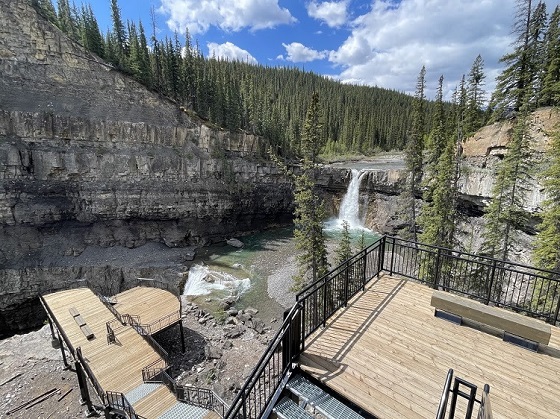Travel
Todayville Travel: The Long Road to Texas

by Gerry Feehan
You would not want to go on an RV trip with me. Plans are inevitably last minute and unpredictable. An innocuous road sign may result in a quick U-turn – and a two-day detour to places unknown.
In early fall we packed our modest motor home and slowly, circuitously ambled from Red Deer southward toward Texas. While impatient snowbirds zoomed by on the interstate en route to a quick, warm Arizona fix, we meandered the back roads, stopping to smell fall’s decaying flowers.

The road to Texas began circuitously, with a detour through Invermere, BC
Our destination was the Texas Gulf but we ultimately took more time getting there than we spent in the Lone Star state.

There’s always time for fishing!
We had no reservations, just a vague malleable plan that, malleably, seemed to change every day. An open travel agenda often leads to pleasant surprises, particularly if one foregoes the freeway for those tranquil country roads. In every backwater town knowledgeable locals are anxious to share wisdom about local pearls. Preconceived plans may go into the rubbish bin but… c’est la vie.
That’s how we stumbled upon Great Sand Dunes National Park. As usual, we had eyed the map one morning, fired up the RV and started to wander. We were lost, headed down the Arkansas River in south Colorado. It was late afternoon. I pulled over and asked directions from a local lady walking her dog.
“Excuse me,” I enquired apologetically of the woman curbing her canine. “I’m a little displaced. Do you know of any campgrounds near here?”
She looked at me, astounded. “Don’t you know that one of America’s great treasures is right there?” She pointed toward a distant, sandy pile fronting the Sangre de Cristo Mountains: Great Sand Dunes National Park.

Great Sand Dunes National Park

We rolled in just as lengthening shadows crept over the vast dunes in a remarkable, rippling display. We set up camp as a bloodshot sun set on the Sahara-like landscape. Coyotes howling at the moon lullabied us to sleep.
In the morning I stepped out into the crisp mountain air. The sand was now shadowed from the east.
We enjoyed our cup of morning joe as dark images, reversed from the night before, played across the dunes. After breakfast we huffed and puffed a thousand feet to the summit of the sand; then ran, child-like, down to the flat plain.
At the visitor center I told a Park Ranger that we were headed toward Texas and asked if there were any other such magical places along the way.
Have you ever been to Palo Duro Canyon State Park?” she asked, pointing to a map of Texas. Palo Duro was directly in our path to the Gulf. Perfect. That afternoon we descended from a Colorado Rocky Mountain high to the bleak, flat scrubland of west Texas. We stopped for the night at “Happy Plains” RV Park in the sleepy town of Texline. We were the only guests. The proprietress, a lonely retired schoolteacher, was happy to shoot the breeze during check-in:
“You’re from Canada? Well, welcome to Texas. My late husband and I drove through Canada once on our way to Alaska. Very friendly people. What’s the name of that National Park? Barff? Great food there, not too spicy.”
I averted my eyes. Florence yawned in an effort to speed up the check-in process. The old gal continued undeterred:
“But Canada was just a little too clean for me. I’ve never been happier than when we finally got to Alaska and saw all the cars jacked up on blocks. Made me feel I was home again. Don’t get me wrong,” she continued, “there is no reason for you to feel ashamed. In fact I believe there is no reason why we wouldn’t welcome you to join us and make one big country.”
“Good idea,” I responded. “We could call it Canada.”
She looked at me quizzically. It hadn’t occurred to her that Canadians might actually cherish their northern independence, that we might like our clean, polite wasteland and that we enjoyed our bland dishes, even if they were served up in “Barff”.
In the morning we hastily broke camp and tried to sneak out the Happy Plains gate. But there stood the lonely matron, blocking our escape route, a basket in hand. She handed me a fistful of chocolate bars. It was Halloween.

Pronghorns near Texline eye the road warily
“I’m sorry about that nonsense last night,” she said, “sometimes I say silly things. ”Don’t we all, sister.
Late that evening we descended into Palo Duro – the “Grand Canyon” of Texas – near Amarillo. Palo Duro is famous for its spectacular red-rock vistas and endless hiking and biking trails. As usual we arrived without reservation. It was a busy weekend. The ranger greeting us was a mountain of a man. His nametag said simply: “Moose”.
“Geez your lucky,” he said. “We’re full up but just had a late cancellation for one of the finest spots in the park.” I shrugged happily. As I affixed the park pass to the windshield, Moose remarked: “Sometimes it pays to travel by the seat of your pants, last minute like.”
Yup, it does.

Palo Dur0- The Grand Canyon of Texas

Travel during the shoulder season means you have entire vistas to yourself – and great weather!
Gerry Feehan QC practised law in Red Deer for 27 years before starting his second life as a freelance travel writer and photographer. He says that, while being a lawyer is more remunerative than travel writing, it isn’t nearly as much fun. When not on the road, Gerry and his wife Florence live in Red Deer and Kimberley, BC. Todayville is proud to work with Gerry to re-publish some of his most compelling stories from his vast catalogue developed over more than a decade of travel.

THANKS to these great partners for making this series possible.
Business
Here’s why your plane ticket is so expensive

From the Fraser Institute
By Alex Whalen and Jake Fuss
While the strike by WestJet mechanics lasted only a few days, many Canadian air travellers faced long delays and cancelled flights. More broadly, according to the Canadian Transportation Agency, customer complaints have hit an all-time high.
Yet many dissatisfied travellers likely don’t realize that Ottawa heavily contributes to their frustrations. Let’s look at the various ways federal policies and laws make air travel worse in Canada.
First, federal laws insulate Canada’s airlines from competition. Foreign airlines are subject to highly restrictive “cabotage” laws which, for example, dictate that foreign airlines cannot operate routes between Canadian cities. At the same time, foreign investors are forbidden from owning more than 49 per cent of Canadian airlines. By restricting international participation in the Canadian air travel market, these laws both deprive Canadian consumers of choice and insulate incumbent airlines from competition. When consumers have more choice, incumbents have a greater incentive to improve performance to keep pace with their competitors.
Second, a wide array of taxes and fees heavily influence the cost of airline tickets in Canada. Airport improvement fees, for example, average $32.20 per departing passenger at airports in Canada’s 10 largest markets. In contrast, airport improvement fees in the United States cannot exceed $4.50. And last year the Trudeau government increased the “air travellers security charge” by 32.85 per cent—this fee, which now ranges from $9.94 to $34.82 per flight, is higher in Canada than the U.S. across all flight categories. On the tax front, in addition to fuel taxes including the federal carbon tax, the federal excise tax on unleaded aviation gasoline in Canada is 10 cents per litre compared to 6.9 cents per litre in the U.S. And the U.S., unlike Canada, does not apply sales taxes to aviation fuel.
Third, air travel is a heavily regulated sector. Federal legislation generates thousands of provisions airlines must follow to operate legally in Canada. Of course, some regulation is necessary to ensure passenger safety, but each regulation adds administrative and compliance costs, which ultimately affect ticket prices. To lower the cost of air travel, the federal government should reduce the regulatory burden while maintaining safety standards.
Lastly, the ownership model of Canada’s airports results in a yearly transfer of rent to the federal government. The federal government used to own Canada’s national system of airports until they were transferred to private not-for-profit corporations in the early 1990s. However, these airports must still pay rent to the federal government—nearly half a billion dollars annually, according to the Canada Airports Council. As with the other examples listed above, these costs are ultimately passed on to consumers in the form of higher ticket prices.
While a precise estimate is difficult to obtain, various government policies, taxes and fees comprise a large share of the cost of each airline ticket sold in Canada. With complaints from travellers at all-time highs, the federal government should reduce the regulatory burden, increase competition, and lower fees and taxes. Policy reform for air travel in Canada is long overdue.
Authors:
Alberta
Just in time for Canada Day weekend! Crescent Falls ready to be enjoyed again

The new staircase structure and viewing platform are among many upgrades that visitors can look forward to at the reopening Crescent Falls Provincial Recreation Area. (Credit: Alberta Parks).
The popular Crescent Falls Provincial Recreation Area reopens following a significant capital investment to improve visitor safety and experiences.
Crescent Falls Provincial Recreation Area is ready to welcome visitors back to enjoy one of the most remarkable, accessible waterfall viewing opportunities in Alberta. The upgrades at Crescent Falls will help improve the park’s visitor experience. Guests can expect expanded parking, improved access roads, trails and day use areas, new and improved viewing areas to take in the falls and upgraded safety measures, including signage and wayfinding.
The Provincial Recreation Area (PRA) is reopening over the July long weekend after being closed since 2023. Visitors will notice increased public safety upgrades through additions such as new parking lots, a new stair structure to access the lower falls, new pedestrian trails, a new vehicle bridge to access the camping area and a viewing platform to enjoy the Crescent Falls.
“We are thrilled to welcome visitors back to Crescent Falls Provincial Recreation Area in time for the Canada Day long weekend. These additions will help visitors to safely access and enjoy the area’s natural beauty. Parks are for people and Alberta’s government will continue to invest in high-quality outdoor recreation opportunities.”
“Today marks a significant milestone for our community as we reopen the Crescent Falls Provincial Recreation Area following extensive upgrades. Our province is well known for its incredible natural beauty, and these improvements will make our backcountry more accessible and ensure that Albertans and those visiting our great province can continue to explore our stunning landscapes for years to come.”
-

 Energy1 day ago
Energy1 day agoB.C. Residents File Competition Bureau Complaint Against David Suzuki Foundation for Use of False Imagery in Anti-Energy Campaigns
-

 Alberta2 days ago
Alberta2 days agoAlberta uncorks new rules for liquor and cannabis
-

 COVID-191 day ago
COVID-191 day agoCourt compels RCMP and TD Bank to hand over records related to freezing of peaceful protestor’s bank accounts
-

 Crime2 days ago
Crime2 days agoProject Sleeping Giant: Inside the Chinese Mercantile Machine Linking Beijing’s Underground Banks and the Sinaloa Cartel
-

 C2C Journal24 hours ago
C2C Journal24 hours agoCanada Desperately Needs a Baby Bump
-

 International1 day ago
International1 day agoTrump transportation secretary tells governors to remove ‘rainbow crosswalks’
-

 Alberta1 day ago
Alberta1 day agoAlberta Next: Alberta Pension Plan
-

 Agriculture12 hours ago
Agriculture12 hours agoLacombe meat processor scores $1.2 million dollar provincial tax credit to help expansion












